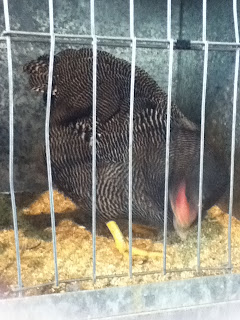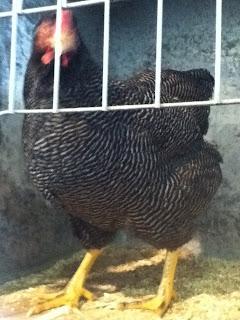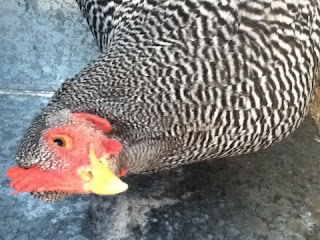Last year I wrote a Red Hen Tale concerning the building of a strain of high producing Reds. There is so much that is contributory to what I told of, then, that it seems feasible to continue along the same line. Am going to give, for what they are worth, some of the actual observations we have made in our work that may be of help to many, and of interest to others.
We are frequently asked how to line breed for production? How to line breed for vigor? How to do these and not inbreed to the injury of the flock? How to introduce new blood for production? How to foretell what the results in production will be from certain matings, and so on.I will try and make clear some of these things as we see them and as our birds indicate.
First in regard to the linebreeding for production. As I have repeatedly written and said the linebreeding chart cannot be followed blindly as in marking out a tennis court. Nature has her own way in spite of all we can do and it is not always our way. The breeding charts are useful in that they indicate a real plan of work; but it is just like the housewife when she has a very special recipe and lacks some ingredient. She has to do the next best way unless she can but the necessary article.
Before proceeding any further it is best to repeat what is said many times, as it has a direct bearing on the uses of the linebreeding chart. It is not always that show birds will reproduce themselves in quality.Neither will the breeders of show birds always produce all show birds.The same with the 200 egg hens. All 200 egg hens will not beget pullets that will lay 200 eggs. Neither will the dam of a 200 egg hen produce ALL 200 eggers. Here is where the chart breeding gets its first bump. Unless each succeeding generation is better than the preceeding, the work is of little value.
Prepotency enters so strongly into all breeding projects that it deserves more attention than it gets. Sometimes we have prepotency reversed, as it might be called, in that this power of transmitting qualities seems to be along the line of inferiority rather than as desired.
The very strict use of the trapnest before very much is done in line breeding is a step forward.Not merely to ascertain the best layers but to find the ones that have the power to give to their offspring get this ability.Along with this must be a reasonable degree of good Standard breeding.We will let the exhibition breeder tell us how to do this and confine ourselves to the production part of the work.
The trapnest can be made the most helpful tool for many who want to actually breed better birdsThrough its use we find the hen that lays the best. The hen that lays the well shelled, large egg. The hen that lays eggs that will produce good looking chicks. The hen that lays eggs that hatch chicks that produce layers of ability. Also the reverse in all these instances. The latter are disposed of.
Without these uses the trapnest is only half paying its way. Take for instance the males from the hens that have produced well themselves,and have been dams of pullets that are extra good layers. These males are most valuable material for the man who cannot trapnest or the one needing new blood for production through the male side.
By the use of the trapnest we find the hen that is healthy. Good layers are never anemic, poor eaters and sluggards. When you have the good layer, if her eggs hatch well, she is doubly valuable.Many of the world's best layers have been very poor in this respect. If her eggs hatch well and in turn her chicks produce pullets that lay well, the chances are strong that the eggs from these pullets will hatch well if the male that sired them was bred from a hen with the same characteristic. This is where it pays to use a new male on only a few females. I have known of cases where people were so frantic to get a male from a super-producer they neglected to learn anything on this score with the result the breeding value ran down fifty percent.
When a scheme of breeding is to be followed it is very essential to have the best possible material to work with. If the above traits are established before the real work is begun much dissapointment can be avoided.
The plan of all linebreeding is to commence with the ideal unrelated pair. Breed them, then their offspring back: females to sire, son to dam then follow the the tracings of the chart as nearly as possible. When we first commenced this work we had very few individuals to work with but had a definite plan to produce better birds as individuals and better layers as a whole. Out of our first venture we found two females out of four that nicked with the male producing BETTER than themselves. Today we have none of the blood of the two that, while good hens, did not mate with the male for good results. By carefully kept records from season to season we used the blood of the first three birds back and forth mating son to dam,daughter to sire, half brother and sister, etc. Today we have a large number of the offspring from these two hens and one male,that are practically 100 per cent the blood of each hen and the one male,yet as individuals, are , as far as breeding purposes are concerned,unrelated, and can be mated with as much safety as to vigor as the original trio. By selecting in each generation the best, both as to colour and type, as well as production the present stock is many hundred per cent better than the original.Each year some distinct trait of the original birds such as in case of one hen who had a comb with many fine serrations,will show up. This year we have chicks removed six generations from her that are seven-eighths her blood that show this comb growth,others exactly the same breeding that did not show this trait so strong.
In line breeding these birds for production the very first thing that was considered was abundant vigor.It is a trait of our birds now just as much as any imaginable inherited quality. Of course good care is important because the most thrifty will not do well without it.On the other hand the best care will not make an inbred, low vitality bird sing and scratch and lay well.
When the chart is carefully studied and used as a guide to breed by, taking into consideration the freaky notions of old DAME NATURE and seeing in them a warning to discard when necessary it is mighty useful.It is like the Auto Route Books--sometimes a road is under repairs and a detour necessary. This is not usually indicated and must be found for the traveller himself. He does not blindly follow the trail as the book indicates, as he would pretty sure come to grief.
The introduction of new blood is often a question of moment. As above remarked it is best to use a new line of blood on only a few females.If your own are reasonably good do not put all your eggs in one basket. Two families, both equally good, do not always, when mated, produce even as good as themselves, as the combination instead of harmonizing is antagonistic. Why? I do not know, enough that it is. As much information as possible is desired about the ancestry of a breeding bird to be used on a good flock. This is not always available as not all breeders are doing intensive trapnesting and pedigreeing. It is a 14 hours a day 365 days a year job and many do not care to be confined so closely.
Where a known prepotent family can supply new blood there is an advantage in that, good results may be quite surely expected as the prepotent male bred on this plan can do more to improve a lot of chicks than a bird bred by accident, as it were.
Thousands ask yearly concerning the certainty of production. It seems they feel they want a guarantee of a certain number of eggs. there is an old saying, "do not count your chickens before they are hatched," which might well be supplementary to "do not count your eggs before they are laid."
I was talking with a breeder of many good birds a little while ago and he told me of an instance at a Boston Show. A woman came to him and asked him if she bought baby chicks, how many eggs a piece he would guarentee the pullets to lay. He told her not one egg. She was very much surprised and could not understand. "Why, Mr._______ just over there is a man who has a 300 egg strain and says every pullet will lay 300 eggs."She was all in good faith. The lesson the breeder drew from this was conclusive---the 300 egg man is no longer in bussiness.
There is no possible way to estimate the number of eggs a bird will lay. The Hogan test will give a very good basis to pick birds from for flock matings. It is seldom that a bird testing well as a layer under this method does not lay well.(However if one wants absolute certainty use the trapnest). There are two things often overlooked in these tests that are really important, especially in picking pullets that have never laid.I have tested out many pullets long before they were any where near production, then watched them when they got settled down. A pullet with soft flexible laterals ( the bones above the breast bone on each side of the abdominal cavity) with a large gizzard will make a good layer if cared for right. These, combined with capacity and pelvic arch are good keys to production.
By the consistent use of the trapnest and linebreeding based on careful selection for ALL POSSIBLE good qualities the man with a small flock can make relatively faster progress than the man with a large flock where individuals are not a known quantity. By a process of careful elimination combined with the establishing of a strong trait of prepotency the smaller number of birds will produce more real good ones than a hit or miss bunch of many times the number.
In the trapnesting of the linebred flock the females are better known and appreciated. Where this is not done and a careful study made of the breeding values of the gentler sex too much attention is paid to the male. He is, in this case, half the pen; there is only one of him and by his masculine aggressiveness he calls attention to himself. Refinement in the females and an appreciation of their individual values are highly important.
The value of a flock of REDS today is not measured by any single characteristic such as phenomenal production, extraordinary exhibition quality, etc, but by a reasonable combination of high class STANDARD qualities and high flock average production.
The one or two splendid specimens in the show room or the 300 egg hen are sensational but the average man or woman with a flock that must be on a paying basis is more interested in the HIGH GENEREAL AVERAGE, This is what we have attempted and, so far, have succeeded to a very pronounced degree and the above article is based on our actual work with actual birds with all the foibles and atavism that make the breeding of GOOD RHODE ISLAND REDS a fit test of the genius and true sportsmanship of the lover of the best in poultry.
Total Pageviews
Saturday, June 16, 2012
Tuesday, June 12, 2012
WINNING LIGHTS AND DARKS PLYMOUTH ROCKS
HERE ARE SOME PRETTY BAD PHOTOS I RUSHED AT THE NATIONAL SHOW JUNE LONG WEEKEEND THEY ARE OF THE WINNING LIGHT HEN AND THE WINNING DARK PULLET AND COCKEREL, WITH A FEW EXTRA THROWN IN. THESE OFFER A PARTIAL REPRESENTATION OF WHAT WE EXPECT OF THE BREED (THE PHOTOS).. SOME LOVELY HEADS AND COLOUR TO LOOK OVER..MY APOLOGIES TO THE OWNERS FOR MY LACK OF PATIENCE...
Subscribe to:
Comments (Atom)


























































